Templot Club Archive 2007-2020
|
|||
| author | remove search highlighting | ||
|---|---|---|---|
|
posted: 7 Feb 2018 23:34 from: Rob Manchester
click the date to link to this post click member name to view archived images |
Hi, Does anybody have experience of modelling light railway track. I have been asked to make a small amount using a light rail section in 7mm standard gauge. I was thinking of using code 100 BH rail as that comes out very close to 60lb/yard full size BH. The option of copper clad sleepers is fine for the sections that will be ballasted over the sleepers with lots of weeds but some needs to have chairs. Can you get these in 7mm scale for code 100 rail ? Rob |
||
|
posted: 8 Feb 2018 00:22 from: Andrew Barrowman
click the date to link to this post click member name to view archived images |
Hi Rob, I believe it was not unusual to use flat-bottom rail spiked to the sleepers for standard gauge light railways in the UK. Code 100 FB might be about right. Google Colonel Stephens Railways Photographs for examples. Cheers, Andy |
||
|
posted: 8 Feb 2018 01:02 from: Rob Manchester
click the date to link to this post click member name to view archived images |
Hi Andy, Yes, just had a look through 'Britains Light Railways' a nice survey of many light rail lines in the UK and you are quite correct that many have FB rail either spiked to the timbers or held there by chair-type screws in biggish square washers that press down either side of the rail foot. The description of 'light rail' is more clearly defined these days but 100 or more years ago was rather vague I suspect. Some of the lines in the above book have very neat track with BH rail and chairs even though the rail is obviously of a smaller section than 'proper' lines. Talking of spiking track Peco offer IL-13 rail spikes that they quote are common to all gauges but they are HUGE. I got some scale HO spikes from the Proto87 guy on your side of the pond a few years ago. They come etched on a sheet and they are very, very small. Just been thinking that maybe copper timbers to solder the rail to and then cosmetic spike heads and nut/bolt/washer detail may be good. Food for thought. Thanks very much for your input. Rob |
||
|
posted: 8 Feb 2018 01:17 from: Martin Wynne
click the date to link to this post click member name to view archived images |
Hi Rob, Here's some Code 87 bullhead rail and matching chairs: http://www.s-scale.org.uk/track.htm regards, Martin. |
||
|
posted: 8 Feb 2018 02:04 from: Andrew Barrowman
click the date to link to this post click member name to view archived images |
Rob Manchester wrote: Hi Andy,Rob, I'm assuming the square screw heads would be about the same as those used for bullhead chairs. What would the approximate dimensions of the clips be in your estimation? I have some FB Code 100 and I can take a shot at printing some samples of sleepers with clips to see how it looks. I've half a mind to dump all my 00 stuff and switch to (battery powered) 0, so it won't be a waste of time Andy |
||
|
posted: 8 Feb 2018 04:30 from: RogerW
click the date to link to this post click member name to view archived images |
Light rail track - the track that we have at Hunsbury Hill is mainly 75lb and a few bits of 65lb. All is flat bottom, mostly spiked with cast steel baseplates to get the correct inward slope of the railheads, and hole for the four spikes. There are also sections using standard chair-screws with big lipped rectangular washers with a flat baseplate with two big holes to take the chairscrews, we also have some ex MOD preformed steel sleepers with special fixings that give chair-like qualities, and some old industrial (or maybe MOD) concrete sleepers with protruding studs that ordinary nuts can fit on (again with the special washers), and there is some concrete with 75lb FB at Rocks by Rail (AKA Rutland). If you want photos I can try and get some of the various types. |
||
|
posted: 8 Feb 2018 04:41 from: RogerW
click the date to link to this post click member name to view archived images |
Practical side - scrap Peco Code 100 OO/HO rail could be utilised on soldered sleepers. I have seen it used on one small O Scale standard gauge layout over at Bedford some years back, but I do not remember it having any cosmetic spikes or bolts/washers |
||
|
posted: 8 Feb 2018 12:53 from: Nigel Brown click the date to link to this post click member name to view archived images |
The term "light railways" arose from the Light Railways Act of 1896, which allowed railways to be built under an order of the Light Railways Commissioners rather than an act of parliament. The commissioners were able to relax certain conditions normally applied to railways, and to define corresponding restrictions, as they saw fit. A common one but by no means universal was the use of ungated level crossings. There was an enormous variety of what was allowed and what the restrictions were. Likewise track and permanent way could be anything from chaired track fully compliant with normal railway standards to lightly laid flat bottom. Here's a couple of pics of Kenton Bank showing chaired track, one at the beginning and one at the end of its existence: http://www.disused-stations.org.uk/k/kenton_bank/ Nigel |
||
|
posted: 8 Feb 2018 13:42 from: Rob Manchester
click the date to link to this post click member name to view archived images |
Thanks to Nigel and RogerW for the prototype background. Martin, those chairs look very nice. I will investigate but need to try and check that 7mm wheels will work with code 87 rail. I suspect Slaters will be OK but the current crop of Heljan/Dapol RTR has slightly less compliant wheels I think. Andy - thanks for the offer. I will let you know on that ( possibly depending on the outcome of Martin's suggestion ) Rob |
||
|
posted: 9 Feb 2018 22:15 from: Rob Manchester
click the date to link to this post click member name to view archived images |
Andrew Barrowman wrote: Hi Rob,Andy, Plenty of talk about Colonel Stephens in this video. Southern England Byways Rob |
||
|
posted: 10 Feb 2018 11:23 from: Stephen Freeman
click the date to link to this post click member name to view archived images |
Hi, If you decide on using Flatbottom can I suggest Karlgarin rail as being a better product? |
||
|
posted: 10 Feb 2018 19:00 from: Rob Manchester
click the date to link to this post click member name to view archived images |
Borg-Rail wrote: Hi,Hi Stephen, Thanks for the suggestion. Think I dealt with Karlgarin some years ago. A motor-biking chap if I remember ? The rail certainly looks nice. I think the code 82 would be fine with Slaters wheel profiles as there wouldn't be any chairs for the flanges to bang on. Any suggestions for spikes ? I know about the Peco and Micro Engineering ones. Rob |
||
|
posted: 10 Feb 2018 20:17 from: Jim Guthrie
click the date to link to this post click member name to view archived images |
Rob Manchester wrote: Any suggestions for spikes ? I know about the Peco and Micro Engineering ones.Rob, I have used the etched spikes from Andy Reichart's Proto:87 Stores in the US http://www.proto87.com/product1908.html I used them for an S scale switching layout and used the middle size of the 0/S spikes. Here's a first test bit of track 25_101504_160000000.jpg 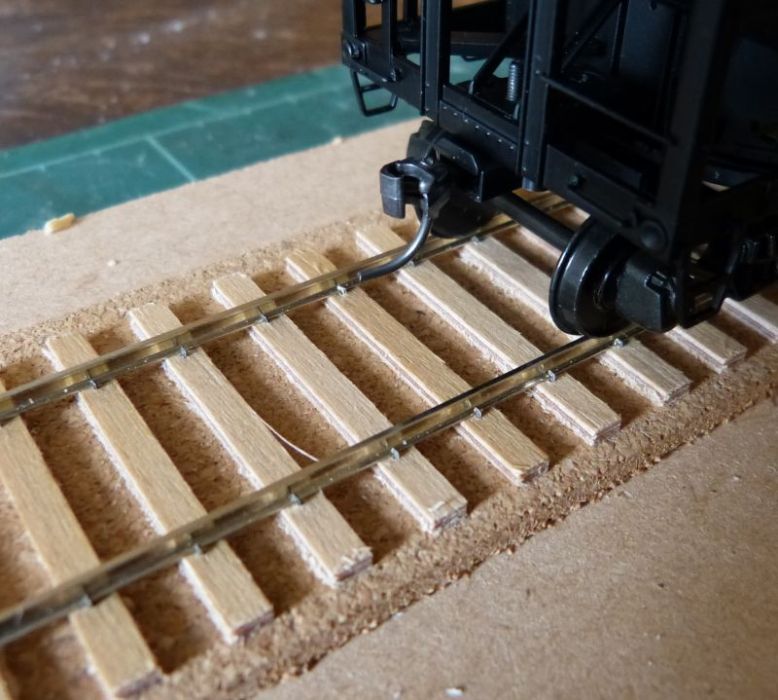 The rail is Peco Code 82 FB. The wheels on the car are Code 110. 25_101504_370000000.jpg 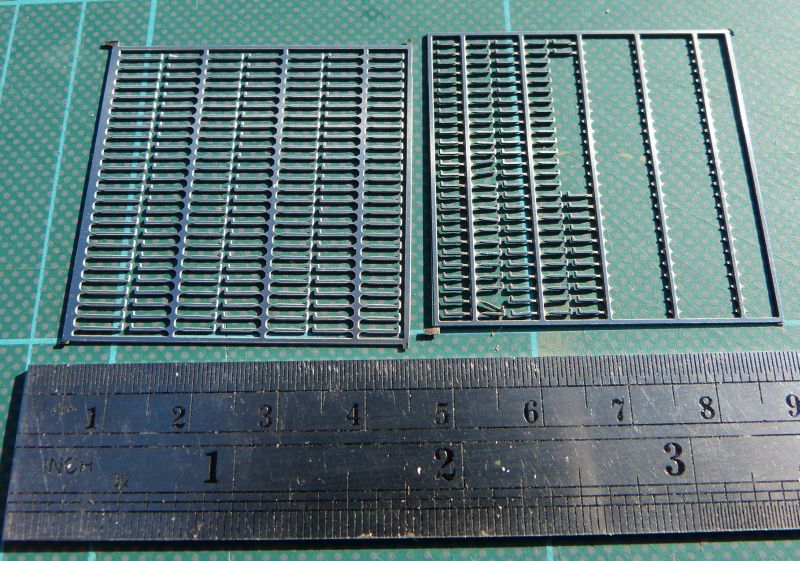 I first got the sample pack from Andy which had all six sizes of spikes and I went for the RH spikes in the picture above. It was well worth it to pick the best size and also to get some experience of whether I could work with them before getting a bulk load of them. I had to drill pilot holes for these spikes since I was using plywood sleepers and there is no way I could drive the spikes into them. The larger dimension of the spike body was around 0.6mm so I used a 0.5mm drill as the pilot and this gave sufficient interference to hold the spikes and didn't provide too much resistance. They were great candidates for "ping". I suspect that about 5% of mine are somewhere in the carpet pile. Jim. |
||
| Last edited on 10 Feb 2018 20:37 by Jim Guthrie |
|||
|
posted: 10 Feb 2018 20:44 from: Rob Manchester
click the date to link to this post click member name to view archived images |
Hello Jim, Many thanks for taking the time to reply. So your S scale track uses the 0.180" long spikes from the longer O and S scale fret ? Did you put glue under the rail or just rely on the spikes to hold it. What did you do when building turnouts ? I am just checking up on the Karlgarin rail suggested by Stephen. That could be a good pairing for standard gauge light railways and an added bonus is I could use the same parts for my On30 track ( assuming I ever get round to all these things). 'Ping' is common with me when building with small components. The workshop ( aka 3rd bedroom - good job I never had kids Thanks again for the info. Rob |
||
| Last edited on 10 Feb 2018 20:44 by Rob Manchester |
|||
|
posted: 11 Feb 2018 00:24 from: Jim Guthrie
click the date to link to this post click member name to view archived images |
Rob Manchester wrote: Hello Jim,Rob, There's actually a bit more of a story about the track. When I first showed the picture above on another forum I was taken to task about the lack of railplates. So I CNC machined railplates from Plastikard to go under the rail and the track then looked like this. 25_101855_120000000.jpg 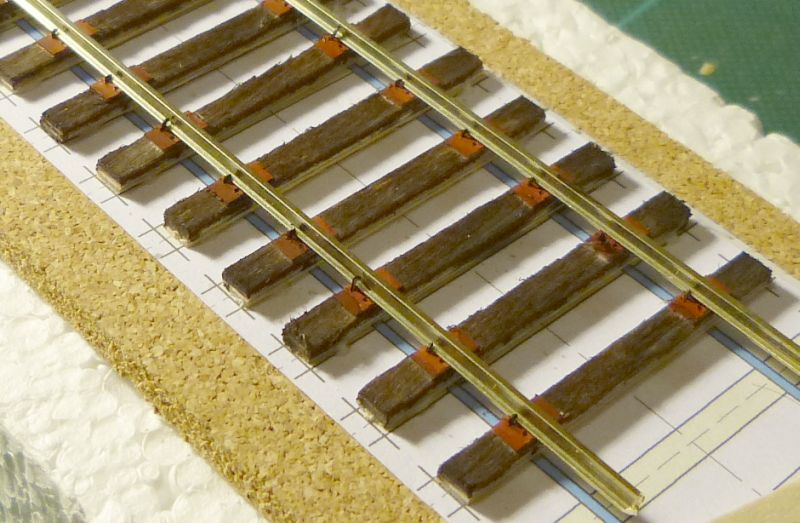 To lay pointwork I laid the timbers on a Templot printout then positioned every fifth or so railplate on the timbers and stuck them down with Butanone. The rails were then spiked through these railplates and checked for gauge. When all looked well, the other railplates were inserted and glued and the spike holes were drilled and the spikes inserted. Here's a turnout partially constructed. 25_101859_200000000.jpg 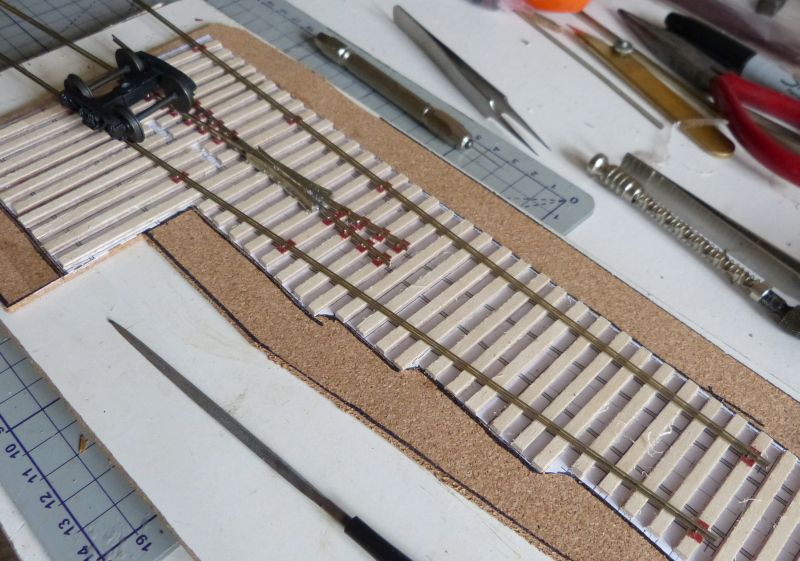 There's also a difference to UK practice since I'm using self-guarding "frogs", so no check rails. However, I did have to lay my diamond crossing and a tandem turnout with standard crossings and check rails and I used a mix of the plastic railplates as above and also nickel silver plates spiked to the timbers to solder the crossing assemblies to. There were short nickel silver plates between stock rails and check rails. 25_101903_160000000.jpg 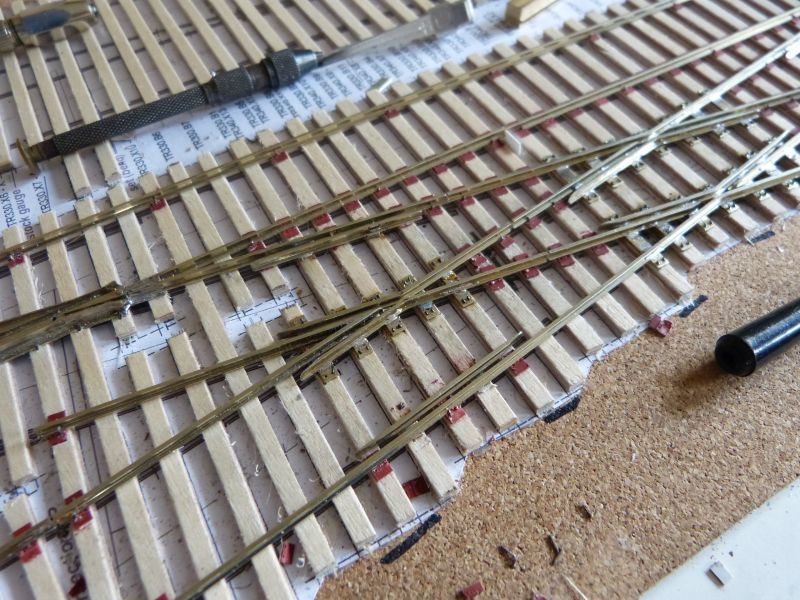 I found the best tools to put the spikes in were two sets of snipe nosed pliers. The larger set has serated jaws which proved handy when spikes were a bit obstinate, but the other, smaller set was the weapon of choice since the ends of the jaws were machined square and were excellent for pushing the spikes fully home. I did have thoughts about making a spiking tool but always opted to persist with the pliers. Also I made a mistake on the size of spike. The ones I used swere the 0.120" 0/S ones. I use 2mm thick sleepers and the 0.120" ones hardly protrude through the base of the sleepers when fully inserted which meant that I could build track and turnouts off the boards. However, I finished up building all the track in situ so I could have used the longer spikes, but for no real reason since the track was sitting on 3mm cork. |
||
| Last edited on 11 Feb 2018 00:25 by Jim Guthrie |
|||
|
posted: 12 Feb 2018 00:20 from: Rob Manchester
click the date to link to this post click member name to view archived images |
Hi Jim, Thanks for the pictures and the write-up. Good stuff, you made a good job of this. I am going to check my stock of track parts in the next few days and build a trial length or two depending on what I can get together. If you think the O/S spikes are bad just look at the size of the HO ones ! Rob |
||
|
posted: 12 Feb 2018 10:08 from: Stephen Freeman
click the date to link to this post click member name to view archived images |
If you decide to use Karlgarin 82 rail, have a look at Palatine Models. Ralph does etched baseplates to suit | ||
|
posted: 12 Feb 2018 18:35 from: Rob Manchester
click the date to link to this post click member name to view archived images |
Borg-Rail wrote: If you decide to use Karlgarin 82 rail, have a look at Palatine Models. Ralph does etched baseplates to suitHi Stephen, Thank you. Yes, I see them on the website now. Rob |
||
| Please read this important note about copyright: Unless stated otherwise, all the files submitted to this web site are copyright and the property of the respective contributor. You are welcome to use them for your own personal non-commercial purposes, and in your messages on this web site. If you want to publish any of this material elsewhere or use it commercially, you must first obtain the owner's permission to do so. |